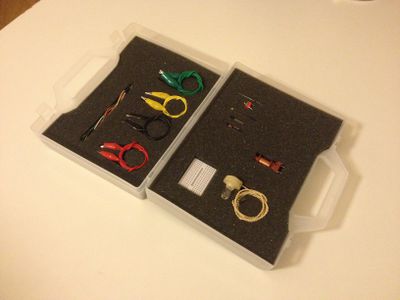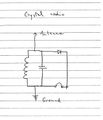Electricity discourse
All matter has electrical properties. The introduced Ultra low voltage survival kit is designed for the analysis and research of the electrical properties in nature including ourselves, the humans. The idea outlined within the following kit is viewed from the perspective of posthuman, a present-future state where the human merges with technology. In Katherine Hayles' terms, it is a state where the human seamlessly articulate with intelligent machines and approaches his or her body as a prosthesis. To be more precise, in Hayles posthumanism there are "no essential differences or absolute demarcations between bodily existence and computer simulation, cybernetic mechanism and biological organism, robot teleology and human goals" (Hayles 1999:2).
The kit (Fig. 1.) introduces two circuits: the LED lit up by energy gained from human body (Fig. 2.) and sound generated from the grounded antenna (Fig. 3.). Proposing to build simple interfaces between living organisms and machines using no battery, the user becomes part of the merged living and not living matter. At the same time the user is invited to dream about technology becoming part of human bodies. This might include deep brain neurostimulators, retinal implants or muscle implants.
Contents
Historical context of the kit
Organisms could be characterized by their ability to conduct electricity which is known since the second half of XVIII century. Edmund Whittaker (1910) mentions 1780s Luigi Galvani's and his assistants' experiments which demonstrated convulsions of frog legs if attached to electric machine and which were considered as animal electricity. A slightly different approach to electricity is presented by Alessandro Volta who in 1799 built his Voltaic Pile known as the first electrical battery (RSC 2015). Described as reaction between chemical elements the Voltaic Pile had two electrodes of different metals placed between pads of moist material. Such set up made possible to demonstrate interaction between organic and not organic matter.
The characterization of organisms capable of electrical conductivity in reference to reaction between nerves (organic) and metals (non organic) instead of animal electricity is brought by Johann Wilhelm Ritter (Berg 2008) after a number of experiments shortly before his death in 1810.
Voltage generated by interaction between organic and non organic elements
The most simple interaction between organic and non organic elements could be described by a lemon battery, generating electricity from chemical reaction between acids and two electrodes of different metals – zinc and copper. The placed within one small or several normal sized lemons, the setup is identical to the Volta's electrical battery. In lemon battery the copper serves as the positive electrode and a piece of zinc as the negative electrode. Citric acid triggers the chemical reaction between negative and positive electrodes generating a small potential difference which in turn becomes the electrical energy (Edinformatics 2015). Electrical energy could also be produced by other plants, like for example potatoes.
During the workshop executed in Vilnius in 2015, together with workshop participants we were trying to experiment with different matter1. All vegetables and fruits brought for the workshop were generating up to 1 V electricity through the attached copper and zinc electrodes. A human body generated 0,4 V electric energy. During further experiments, while connecting five fruits and vegetables in series, the generated 4 V of electric energy could light up an LED. Similarly, connecting seven workshop participants into the series produced 2 V of electric energy. Although the amount of voltage might have been enough to light up LED, the lack of current was prevented lighting up an LED.
Nevertheless an LED could be lit up with one human body combining several electronic components into the circuit. An example showing such an experiment is published on Youtube by the user with a nickname slider2732.2 Here the “battery” consists of human body, a couple of capacitors, resistor, a semi conductive stone like a ferrite or pyrite with copper wire and a piece of aluminum.
Workshops
Human Battery
The simplified version of the LED lit up from human body is introduced by Youtube user. It could be sketched up as shown in Fig. 2 (left).
Fig. 2. LED lit up from human body (left) and the circuit for it (right). Within the circuit the electrode marked V+ is meant to be copper and the electrode marked V- is meant to be aluminum. The copper electrode could be replaced with e.g. graphite and aluminum with zinc. Other variations are also possible.
Crystal Radio
Along the lit up LED, the Ultra low voltage survival kit introduces generated sounds with no use of traditional battery. The inspiration for this project came from Joe Davis “Bacterial Radio,” a Golden Nica awarded project (Davis 2012). Although the kit introduces traditional and simplified version of radio receiver, the mentioned project of Davis introduces organic wires carrying electric energy. The project itself refers to biotechnology which eventually should replace traditional machines based on silicon: “the promise of this research is that microbial machinery will eventually carry out many operations now carried out by heavy industry, but with fewer resources and without environmental pollution” (Davis 2012). The basic crystal radio and its circuit are shown in Fig. 3.
“A crystal radio is a basic resonant circuit requiring only induction, capacitance and a radio 'crystal,' a mineral semiconductor used to convert received radio signals into DC electrical signals that can be resolved with headphones as sound. These simple circuits require no batteries, tubes or transistors and operate with only the difference in voltage between the antenna and the ground.” (Davis 2012).
Fig. 3. Crystal radio (left) and the circuit (right).
Conclusions
The introduced circuits producing light and sound with no additional voltage illustrate posthuman state, which is defined by Katherine Hayles as a merge of human body and silicon based technology. Chemical reactions transducing energy into light and sound demonstrate interactivity between organic and non organic matter. Therefore the use of organic matter in connection with electric circuit might be considered within the posthuman context.
References
- Berg, H. (2008). Johann Wilhelm Ritter – The Founder of Scientific Electrochemistry in Review of Polarography, Vol.54, No.2. Available at: https://www.jstage.jst.go.jp/article/revpolarography/54/2/54_2_99/_pdf (Accessed: 1 August 2015).
- Davis, J. (2012). Bacterial Radio. Available at: http://prix2012.aec.at/prixwinner/7023/ (Accessed: 14 May 2016).
- Edinformatics (2015). How does a battery work. Available at: http://www.edinformatics.com/math_science/how_does_a_battery_work.htm (Accessed 3 August 2015).
- Hayles, N. K. (1999). How We Became Posthuman: Virtual Bodies in Cybernetics, Literature, and Informatics. Chicago: The University of Chicago Press.
- RSC (2015). Enterprise and electrolysis... Available at http://www.rsc.org/chemistryworld/Issues/2003/August/electrolysis.asp (Accessed: 3 August 2015).
- slider2732 (2013). No Battery - LED Flasher. Available at: https://www.youtube.com/watch?v=STPej7VQNzI (Accessed 13 May 2016).
- Whittaker, E. T. (1910). A history of the theories of aether and electricity. Vol 1, Nelson, London. Available at: https://archive.org/download/historyoftheorie00whitrich/historyoftheorie00whitrich_bw.pdf (Accessed: 1 August 2015).
Footnotes
[1] “Do-it-yourself” series workshop “How To Light Up LED With Your Body” with artist Mindaugas Gapševičius. Available at: http://www.letmekoo.lt/en/pasidaryk-pats-dirbtuves-kaip-iziebti-led-savo-kunu-su-menininku-mindaugu-gapseviciumi/ (Accessed 11 August 2015).
[2] No Battery - LED Flasher. Available at: https://www.youtube.com/watch?v=STPej7VQNzI (Accessed 13 May 2016).










